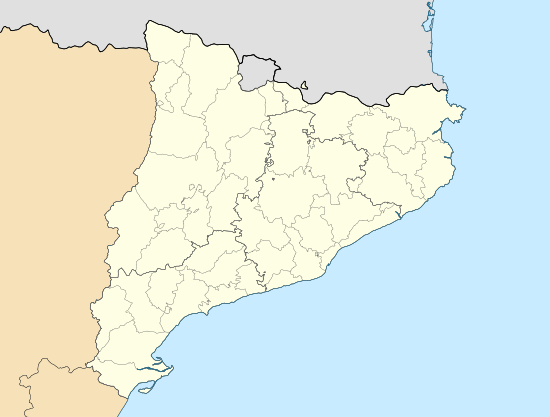Blancafort, Tarragona
| Blancafort | |||
|---|---|---|---|
| Municipality | |||
 | |||
| |||
 Blancafort Location in Catalonia | |||
| Coordinates: 41°26′24″N 1°09′38″E / 41.44°N 1.1606°ECoordinates: 41°26′24″N 1°09′38″E / 41.44°N 1.1606°E | |||
| Country |
| ||
| Autonomous community |
| ||
| Province |
| ||
| Comarca |
| ||
| Government | |||
| • mayor | Magí Baltà Ventura (2015)[1] | ||
| Area[2] | |||
| • Total | 14.5 km2 (5.6 sq mi) | ||
| Population (2014)[1] | |||
| • Total | 413 | ||
| • Density | 28/km2 (74/sq mi) | ||
| Time zone | CET (UTC+1) | ||
| • Summer (DST) | CEST (UTC+2) | ||
| Website |
www | ||
Blancafort, Tarragona is a village in the province of Tarragona and the autonomous community of Catalonia, Spain.
History
Blancafort was first mentioned in 1207 census documents in which a castle in the name of Pere Romeu y de Fitor Arnau was noted. Blancafort was part of the Dukedom of Montblanc. It was fortified in the fourteenth century. During the War of Succession it declared itself in favor of the Archduke Charles so it was attacked by Philip V's troops. After the war, it was integrated into the township of Tarragona. During the War of Independence it was looted by troops commanded by the French General, Louis Gabriel Suchet.
Culture
The parish church is dedicated to Saint Magdalene and was built on the remains of the ancient Roman temple. It is of ample proportions and of a late Baroque style. It consists of a single nave and a barrel vault cover. The façade is neoclassical. In the old cemetery attached to the temple there is an outstanding collection of preserved tombstones which are today on display in the Diocesan Museum of Tarragona.
The town retains many houses built in the late eighteenth century. Among them is the Can Minguella, better known as the Can Cavaller, from the seventeenth century. The façade shows the family coat of arms. Nothing remains of the old castle except a topographical reference in the street name del Castell.
Blancafort's main festival takes place on the fourth Sunday of August, although for the entire month of August there are activities for people of different ages. Since 1483, there is also a tradition of walking up to the Sanctuary of Tallat, also done during the month of August.
References
- 1 2 "Ajuntament de Blancafort". Generalitat of Catalonia. Retrieved 2015-11-13.
- ↑ "El municipi en xifres: Blancafort". Statistical Institute of Catalonia. Retrieved 2015-11-23.
External links
- Official website
- Generalitat of Catalonia - data
- Statistical Institute of Catalonia - The municipality in figures
 |
Vallbona de les Monges |  | ||
| L'Espluga de Francolí | |
Solivella | ||
| ||||
| | ||||
| Montblanc | Pira |

